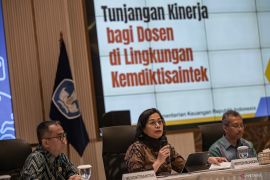He said the product was used for Gas Chromatography analysis and desiccator dryers in the packaging form for drying foodstuffs and reducing moisture in leather bags, leather shoes, belts, and medicine in capsule form. The product of the chemical industry is named Silica 60, which will be distributed in the form of crystals and powder.
“Industrial silica gel has a relatively high price in limited packaging. Hence, we conducted research in the synthesis of silica gel (SG) materials using waste," Ngatijo noted in Jambi on Saturday.
He later remarked that the SG synthesis process began with the manual burning of rice hulls followed by a furnace burning method at a temperature of 700 degrees Celsius at the university's chemistry laboratory.
He expounded that the SG production utilizes waste in the manufacturing process, specifically agricultural waste in the form of converted rice hulls resulting in ash, corn cobs, sweet potato stalks, and stems and roots of weed grass synthesized into substances that are useful as adsorbents.
Agricultural waste is used as a source of silica and then processed into sodium silicate. With the acid reaction process, Ngatijo was able to produce the finishing product of the silica gel.
In addition, other household waste, such as glassware, glasses, plates, bowls, ashtrays, mirrors, and car glass, can be used as materials to produce silica gel.
Related news: Combating mercury use in gold mining remains a challenge: ministry
"By chemical reaction, we can convert waste glass into silica," he stated.
In the adsorption process, Ngatijo explained several aspects related to its use. In addition to dealing with pollutants in the environment, adsorption can be used for metal extraction that has a high economic value, such as the extraction of gold, platinum, copper, and rare earth elements, such as zirconium.
"For gold adsorption in the form of anions, we have developed a Solid Phase Extraction (SPE) method that has a higher ability than conventional adsorption through a shaker," Ngatijo remarked.
This research received decentralized funding from the Directorate General of Higher Education (Ditjen Dikti) in 2016, 2017, and 2018. This was followed by the adsorption technique that uses Ionic Imprinted Polymer funded by Dikti in 2021 and 2022.
Based on several types of research been conducted with multi-year funding, Ngatijo plans to apply this method for traditional gold miners to work more effectively and efficiently.
Related news: Government pushes reduction, elimination of mercury in four sectors:
Translator: Tuyani, Resinta Sulistiyandari
Editor: Rahmad Nasution
Copyright © ANTARA 2022












